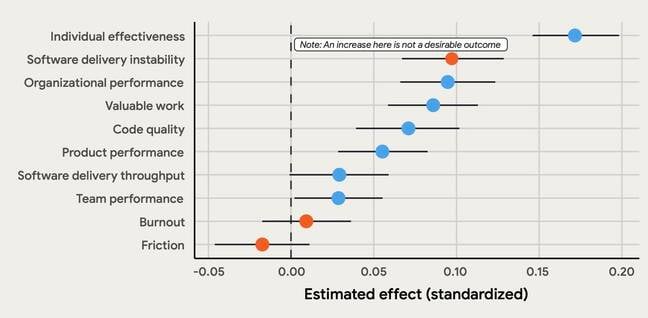
Google Cloud’s 2025 DORA (DevOps Research and Assessment) report is out, claiming that since 90 percent of respondents now make some use of AI for software development, the question is not whether to adopt it but how to realize its value.
The research is based on nearly 5,000 survey responses from IT professionals, interpreted by the DORA team. The DORA research project is long-standing with annual reports since 2014, acquired by Google in December 2018.
The highest use of AI is for writing new code (71 percent of developers), and the most common interaction with AI is via chatbots (among all users, not all of whom are coders), followed by IDEs (integrated development environments). Use of agent mode, where AI makes changes autonomously, is less common, with 61 percent saying they never do this and only 17 percent doing so once a day or more often.

The estimated effect of AI adoption on key outcomes, from the 2025 DORA report
Although 80 percent of those surveyed believe AI has increased productivity, there are drawbacks. 30 percent do not trust AI-generated code, AI increases delivery instability, and overall AI acts as an amplifier, increasing the strength of high-performing organizations but worsening the dysfunction of those that struggle, the report states.
Included in the research paper is the DORA AI Capabilities Model with seven technical and cultural best practices for AI adoption. These comprise clear communication of AI usage policies, high quality internal data, AI access to that data, strong version control, small batches of work, user-centric focus, and a high quality internal platform. This last is vaguely defined but refers to the software and systems on which developers build applications and services.
Gene Kim, co-founder of the DORA project and well-known for books on effective DevOps including The Phoenix Project, has contributed to the report. He describes how he, along with the verbose and influential dev blogger Steve Yegge (ex Amazon and Google), embraced vibe coding and has written a book on the subject. They saw how it could go wrong, he wrote, “resulting in deleted tests, outages, and even deleted code repositories.”
Nevertheless it changed their lives, they claim, enabling faster and more ambitious projects. In consequence, Kim writes, “our control systems – that’s us – must also speed up” with fast feedback loops, independent testing and deployment systems, and a climate for learning given the “idiosyncratic nature of AI and its rapid rate of advance.”
The DORA research divides DevOps teams into seven team archetypes, numbered roughly in order of desirability, with the lowest named Foundational challenges and the highest called Harmonious high-achiever. The teams are defined on the basis of six metrics, these being product performance, software delivery throughput, software delivery instability, burnout, friction, and valuable work.
According to the report, 10 percent of respondents are stuck at the lowest level, 20 percent are at the highest, and 45 percent are at the fifth level or higher.
The full report has 440 pages of more detail.
The 2025 report represents a dramatic shift in focus towards AI for the DORA project. The 2024 report also featured AI, though its conclusions were mixed and measured. “AI does not appear to be a panacea,” it reported at the time, and although there was evidence in favor of adopting AI, “there are plenty of potential roadblocks, growing pains, and ways in which AI might have deleterious effects.” One such effect was reduced software delivery stability and throughput.
In 2024 and in previous years, the DORA research assessed software delivery performance based on four keys: change lead time between code commit and deployment, deployment frequency, change fail rate, and failed deployment recovery time. In 2025, these are referenced only in a footnote, as one of many ways to measure software development.
What has caused the DORA team to shift its stance towards AI? Kim states in the 2025 paper that “I started calling last year’s report and its findings ‘the DORA 2024 anomaly’.” In his view, what needs to change is the way DevOps is practiced in the AI era.
Unless the rate of AI adoption slows (and we note that Google is invested in this not happening), promoting best practice around how it is used may be the pragmatic option, even among sceptics. ®
Bootnote
The DORA report is now called the “State of AI-assisted software development” where previously it was called the “Accelerate State of DevOps.”
